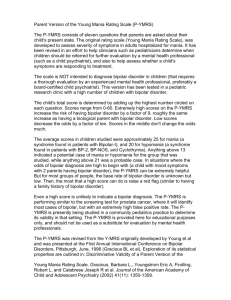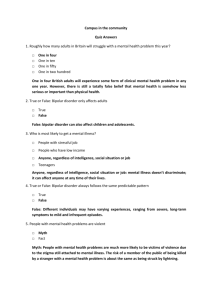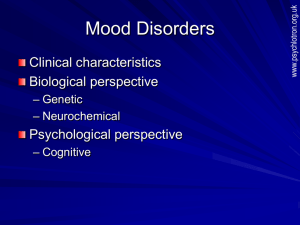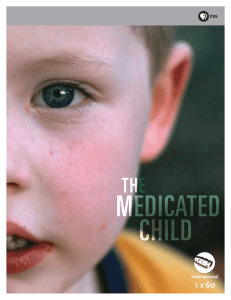Bipolar Disorder - Harlem Children Society
advertisement
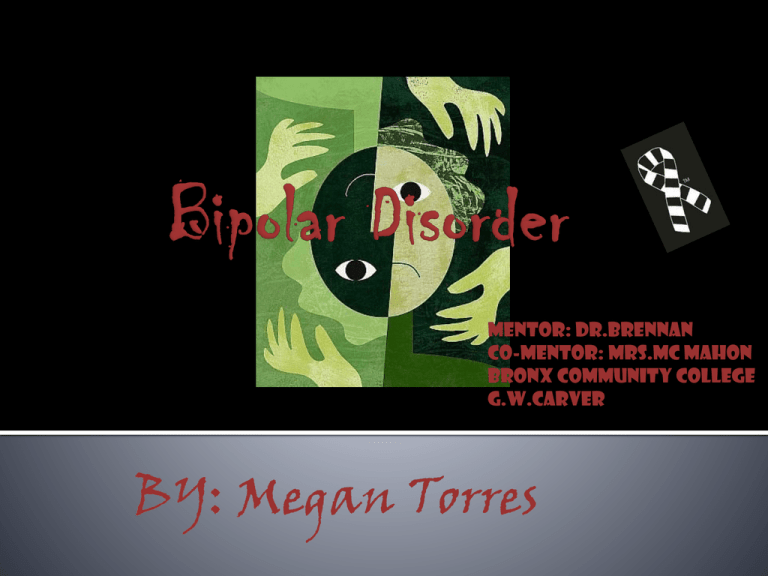
Mentor: Dr.brennan CO-Mentor: mrs.Mc Mahon Bronx Community college g.w.carver BY: Megan Torres Overview What is bipolar? Statistics/Graphs Risks Symptoms Rapid cycling/BP1 BP2 Diagnosis Bipolar medication Bipolar treatment The FAT gene Future References Acknowledgements Thank you! =] Bipolar disorder is a mental illness that consists of quick mood shifts. It is also known as manic depression because one moment you can be happy, excited, hyper and the next angry, frustrated or sad and depressed. Sometimes bipolar disorder can be dangerous for the patient as well as the people surrounding them but only in extreme cases. It is much more than shifts between elation and depression. The reason I am doing this disease is because I personally know someone with the disease and I would like to conduct experiments on it and educate myself and others as much as I can. -More than 2/3rds of people with bipolar have at least one close relative with bipolar or depressive disorders. -2.6% or 5.7million adult(18 and older) Americans are affected by bipolar disorder -The median age of onset BP is age 25 but it can happen at any age -Almost an equal amount of men and women have BP (it does not discriminate either) Euthymic: pertaining to a normal mood when you are neither highly elated or highly depressed -Although men and women develop BP equally women almost 3 times more than men experience rapid cycling -Women with BP have more depressive episodes and more mixed episodes than do men with the illness -Bipolar disorder results in about 9 yrs. Reduction in expected life span and 1 in 5 BP patients commit suicide -20% of adolescents with major depression develop bipolar disorder within 5 yrs. Of the onset of depression General Population 1% 2nd degree relative (aunt/uncle) 3-7% Sibling 15-25% Fraternal twin 15-25% Identical twin 70% One of your parents 15-30% Two of your parents 50-75% 1. 2. 3. Unexplained aches and pains: caused by physical stress, insomnia (sleep deprivation). People with depression problems or bipolar have more of the stress hormone cortisol Weight loss or Weight gain: depressed people or people with mental illnesses tend to not eat because of appetite or rely on food to comfort them Decreased or Increased appetite: due to medicine they may be taking or effect on the brain. 4. 5. Psychomotor agitation: an increase in activity caused by mental tension. This typically includes pacing, wringing hands, finger or foot taping which is categorized by restlessness. Psychomotor retardation: referring to the slowing of both thought and physical activities as simple as brushing your teeth or eating Rapid cycling -this describes a person who as four or more mania episodes a year 10% to 20% of people with bipolar experience this (a mania episode is a period of abnormally elevated mood that can disrupt everyday life) Bipolar 1 -Person with this experience at least I manic episode in their lifetime Bipolar 2 -this is similar to BP 1 but their “up” never reaches full on mania There are 4 main things doctors check for or go over to diagnose bipolar disorder. -A complete medical history and physical exam -A complete psychiatric history -Family history of medical and psychiatric history -Evaluation of current symptoms Mood stabilizers. These may delay or relieve episodes of mania or depression They can help people go longer between mood episodes. Antidepressants. These are often used with a mood stabilizer in people with depressive episodes. If used alone, antidepressants may increase the chances of a person with bipolar disorder switching into mania. Antipsychotics. These are medicines that are mostly used to treat mania. They may also be used to treat psychosis that can occur during severe episodes of mania or depression. Patients with severe anxiety or agitation may also receive antipsychotics. Antipsychotics may be used alone or with other medicines for treating bipolar disorder. Other medicines might be suggested by the healthcare provider when a person with bipolar disorder cannot sleep or feels nervous. Electroconvulsive therapy (ECT) is not a medicine. It is a medical treatment used to help people with severe mania or depression. It can also help people who do not do well with medicine. To control symptoms of depression and mania To reduce number of times mania episodes happen To help people with bipolar feel the best they can To reduce symptoms that may still be a problem The FAT gene is a newly found gene that scientists believe is a gene that plays a big role in developing bipolar disorder. The FAT gene is responsible for a protein involved in connecting brain cells together. A team of researchers from Australia announced their findings on this gene in January. The gene was discovered because BP is an organic brain disorder and was thought to be connected to a gene, which lead them to experiments. "We are the first group in the world to take a multi-faceted approach to identify a bipolar risk gene - we used a number of families, unrelated patients, and therapeutic drug mouse models. Each of these three lines of investigation led us to a gene called FAT." –Dr. Ian Blaire . Chromosome 13 Position q33 on chromosome 13 FAT gene is located on the 13th chromosome position 13q33 In the future I would like to conduct actual experiments, such as using mice and knocking out the FAT gene and observing the results. I would also like to survey people with BP and get their views on the disease and life with the disease. http://www.bipolar.com/ http://www.nimh.nih.gov/health/topics/bipolar-disorder/index.shtml http://www.webmd.com/bipolar-disorder/guide/bipolar-disorder-symptoms-types http://mayoclinic.com/health/bipolar-disorder/DS00356 http://www.ncbi.nlm.nih.gov/gene/79070?ordinalpos=1&itool=EntrezSystem2.PEntrez.Gene.Gene_ResultsPanel.Gen e_RVDocSum http://www.bipolar.com/treatment_options/medicines.html http://www.mayoclinic.com/health/electroconvulsive-therapy/MY00129 ^ http://linkinghub.elsevier.com/retrieve/pii/S0165032702004627 ^ http://www.mental-health-matters.com/articles/article.php?artID=1176 ^ http://www.nimh.nih.gov/health/publications/bipolar-disorder/what-are-the-symptoms-of-bipolar-disorder.shtml ^ Kessler, RC; Chiu WT, Demler O, Walters EE (2005). "Prevalence, severity, and comorbidity of twelve-month DSM-IV disorders in the National Comorbidity Survey Replication (NCS-R)". Arch Gen Psychiat 6: 617–27. PMID 15939839. http://archpsyc.ama-assn.org/cgi/content/full/62/6/617. ^ "Bipolar Disorder: Signs and symptoms". Mayo Clinic. http://www.mayoclinic.com/health/bipolardisorder/DS00356/DSECTION=2. ^ NIMH · Bipolar Disorder · Complete Publication ^ NIMH · Bipolar Disorder · Complete Publication ^ http://www.pueblo.gsa.gov/cic_text/health/bipolar/bipolar.htm ^ "Bipolar Disorder: Complications". Mayo Clinic. http://www.mayoclinic.com/health/bipolar disorder/DS00356/DSECTION=7. ^ Bergen M (1999). Riding the Roller Coaster: Living with Mood Disorders. Wood Lake Publishing Inc.. ISBN 9781896836317 I would like to thank. -Dr. Brennan -Mrs. McMahon -Bronx Community College -Eric Konadu -Jordan Liz -Patrick Mahoney -Dr.Sat -HCS staff -Dr. Bondoc And all you for listening!=] -

